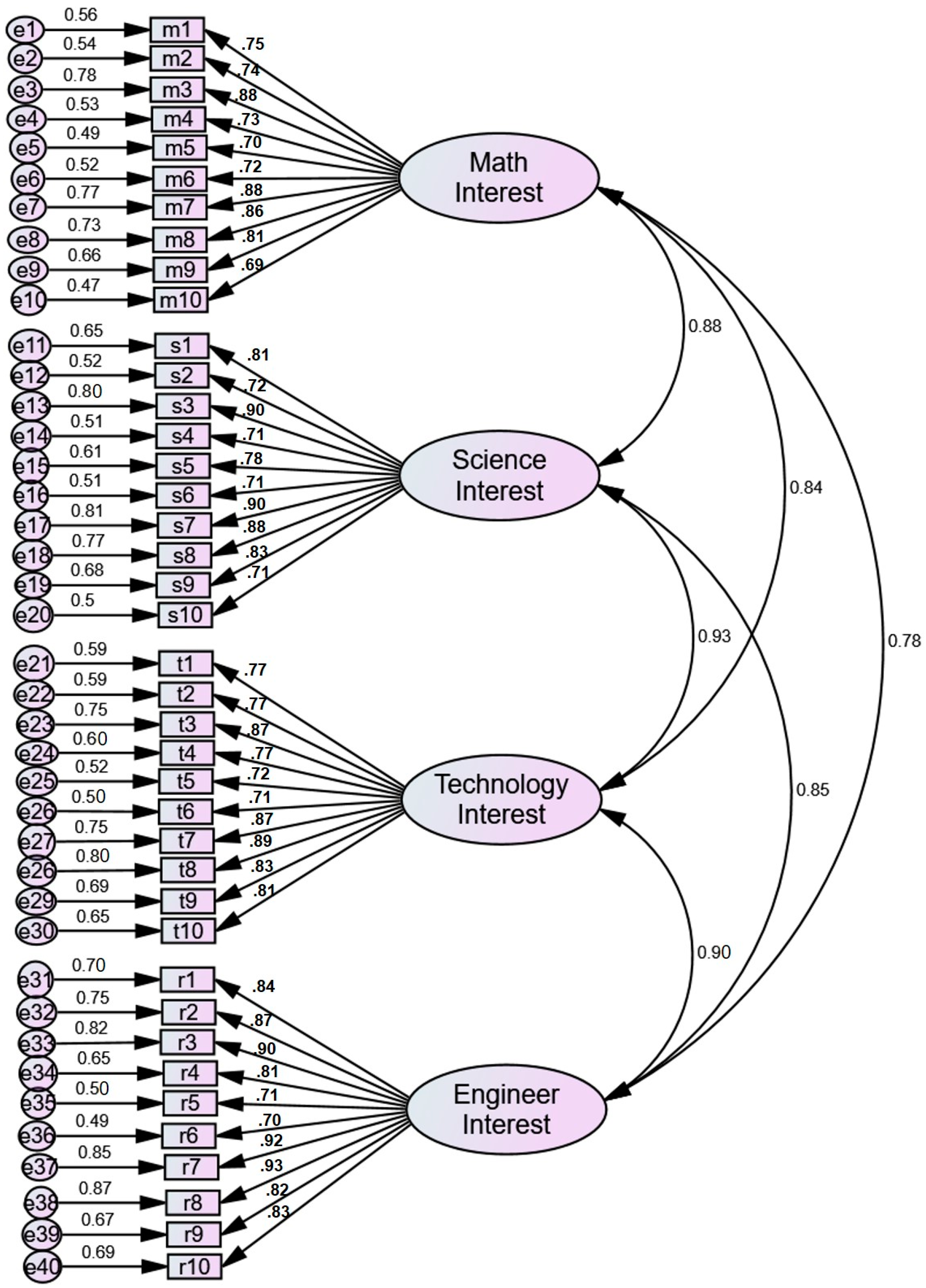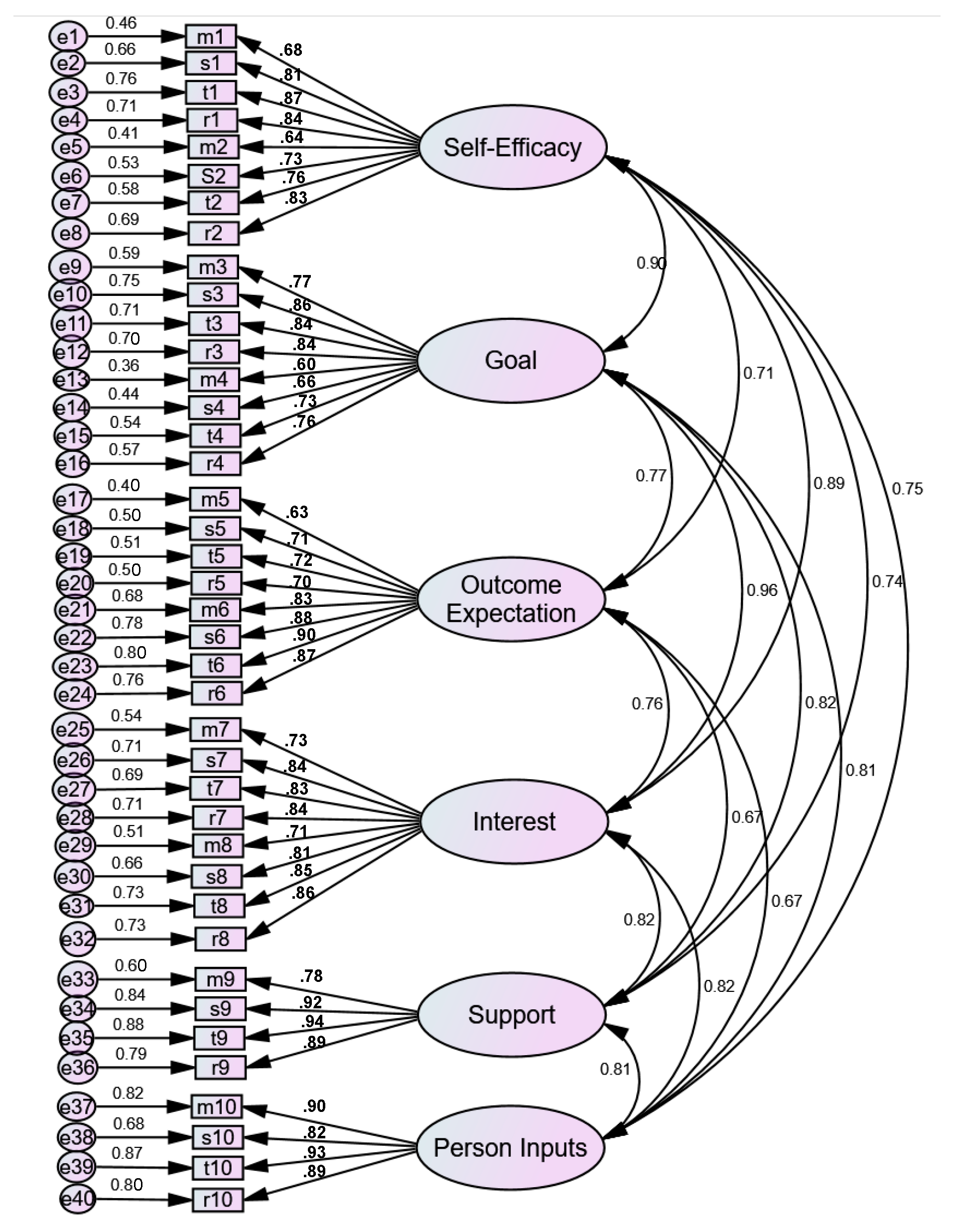Assessing High School Student’s STEM Career Interests Using a Social Cognitive Framework
Abstract
1. Introduction
1.1. Theoretical Framework
1.2. The Current Study
2. Methods
2.1. Participants and Procedures
2.2. Measures
2.3. Statistical Analysis
3. Results
3.1. Descriptive Statistics and Reliability
3.2. Confirmatory Factor Analyses
3.2.1. Discipline-Specific Model
3.2.2. SCCT Model
4. Discussion
4.1. Implications
4.2. Conclusions
Author Contributions
Funding
Acknowledgments
Conflicts of Interest
References
- National Science Board. Science and Engineering Indicators 2016; National Science Foundation (NSB-2016-1): Arlington, VA, USA, 2016.
- ACT. STEM Education in the U.S.: Where We Are and What We Can Do. 2018. Available online: http://www.act.org/content/act/en/research/stem-education-in-the-us-2017.html (accessed on 13 June 2019).
- United Nations Development Programme. Human Development Report 2015: Work for Human Development; United Nations Development Programme: New York, NY, USA, 2015. [Google Scholar]
- Anderson, E.; Kim, D. Increasing the Success of Minority Students in Science and Technology; American Council on Education: Washington, DC, USA, 2006. [Google Scholar]
- Dowd, A.C.; Malcom, L.E.; Bensimon, E.M. Benchmarking the Success of Latina and Latino Students in STEM to Achieve National Graduation Goals; University of Southern California: Los Angeles, CA, USA, 2009; Available online: https://cue.usc.edu/files/2016/01/Dec_2009_NSF_Report_FINAL.pdf (accessed on 13 June 2019).
- National Science Foundation. Women, Minorities, and Persons with Disabilities in Science and Engineering: 2015; Special Report NSF 15-311; National Science Foundation: Arlington, VA, USA, 2015.
- Lent, R.W.; Brown, S.D.; Hackett, G. Toward a unifying social cognitive theory of career and academic interest, choice, and performance. J. Vocat. Behav. 1994, 45, 79–122. [Google Scholar] [CrossRef]
- Rottinghaus, P.J.; Falk, N.A.; Park, C.J. Career Assessment and Counseling for STEM: A Critical Review. Career Dev. Q. 2018, 66, 2–34. [Google Scholar] [CrossRef]
- Lent, R.W.; Miller, M.J.; Smith, P.E.; Watford, B.A.; Lim, R.H.; Hui, K.; Morrison, M.A.; Wilkins, G.; Williams, K. Social cognitive predictors of adjustment to engineering majors across gender and race/ethnicity. J. Vocat. Behav. 2013, 83, 22–30. [Google Scholar] [CrossRef]
- Mau, W.C.; Li, J. Factors influencing STEM career aspirations of underrepresented high school students. Career Dev. Q. 2018, 66, 246–258. [Google Scholar] [CrossRef]
- Nauta, M.M.; Epperson, D.L. A longitudinal examination of the social-cognitive model applied to high school girls’ choices of nontraditional college majors and aspirations. J. Couns. Psychol. 2003, 50, 448–457. [Google Scholar] [CrossRef]
- Patrick, L.; Care, E.; Ainley, M. The relationship between vocational interests, self-efficacy and achievement in the prediction of educational pathways. J. Career Assess. 2011, 19, 61–74. [Google Scholar] [CrossRef]
- Sahin, A.; Ekmekci, A.; Waxman, H.C. The relationships among high school STEM learning experiences, expectations, and mathematics and science efficacy and the likelihood of majoring in STEM in college. Int. J. Sci. Educ. 2017, 39, 1549–1572. [Google Scholar] [CrossRef]
- Zarrett, N.R.; Malanchuk, O. Who’s computing? Gender and race differences in young adults’ decisions to pursue an information technology career. New Dir. Child Adolesc. Dev. 2005, 110, 65–84. [Google Scholar] [CrossRef][Green Version]
- Byars-Winston, A.; Fouad, N.A. Math and science social cognitive variables in college students. Contributions of contextual factors in predicting goals. J. Career Assess. 2008, 16, 425–440. [Google Scholar] [CrossRef]
- NCES. Gender Differences in Science, Technology, Engineering, and Mathematics (STEM) Interest, Credits Earned, and NAEP Performance in the 12th Grade (NCES 2015-075); National Center for Education Statistics, Institute of Education Sciences, U.S. Department of Education: Washington, DC, USA, 2015.
- Toker, Y.; Ackerman, P.L. Utilizing occupational complexity levels in vocational interest assessments: Assessing interests for STEM areas. J. Vocat. Behav. 2012, 80, 524–544. [Google Scholar] [CrossRef]
- Miller, K.; Sonnert, G.; Sadler, P. The influence of students’ participation in STEM competitions on their interest in STEM careers. Int. J. Sci. Educ. Part B 2018, 8, 95–114. [Google Scholar] [CrossRef]
- Li, J.; Mau, W.C.; Chen, S.J.; Lin, T.C.; Lin, T.Y. A qualitative exploration of STEM career development of high school students in Taiwan. J. Career Dev. 2019. [Google Scholar] [CrossRef]
- Tyler-Wood, T.; Knezek, G.; Christensen, R. Instruments for assessing interest in STEM content and careers. J. Technol. Teach. Educ. 2010, 18, 341–363. [Google Scholar]
- Usher, E.L. Sources of middle school students’ self-efficacy in mathematics: A qualitative investigation. Am. Educ. Res. J. 2009, 46, 275–314. [Google Scholar] [CrossRef]
- Lent, R.W.; Brown, S.D. On Conceptualizing and assessing social cognitive constructs in career research: A measurement guide. J. Career Assess. 2017, 14, 12–35. [Google Scholar] [CrossRef]
- Bandura, A. Social Foundations of Thought and Action: A Social Cognitive Theory; Prentice-Hall: Englewood Cliffs, NJ, USA, 1986. [Google Scholar]
- Sheu, H.; Lent, R.W.; Brown, S.; Miller, M.; Hennessy, K.; Duffy, R.D. Testing the choice model of social cognitive career theory across Holland themes: A meta-analytic path analysis. J. Vocat. Behav. 2010, 76, 252–264. [Google Scholar] [CrossRef]
- Fouad, N.A.; Hackett, G.; Smith, P.L.; Kantamneni, N.; Fitzpatrick, M.; Haag, S.; Spencer, D. Barriers and supports for continuing in mathematics and science: Gender and educational level differences. J. Vocat. Behav. 2010, 77, 361–373. [Google Scholar] [CrossRef]
- Garriott, P.O.; Flores, L.Y.; Prabhakar, B.; Mazzotta, E.C.; Liskov, A.C.; Shapiro, J.E. Parental support and underrepresented students’ math/science interests: The mediating role of learning experiences. J. Career Assess. 2014, 22, 627–641. [Google Scholar] [CrossRef]
- Lent, R.W.; Brown, S.D.; Schmidt, J.; Brenner, B.; Lyons, H.; Treistman, D. Relation of contextual supports and barriers to choice behavior in engineering majors: Test of alternative social cognitive models. J. Couns. Psychol. 2003, 50, 458–465. [Google Scholar] [CrossRef]
- Lent, R.W.; Brown, S.D.; Sheu, H.B.; Schmidt, J.; Brenner, B.R.; Gloster, C.S.; Treistman, D. Social cognitive predictors of academic interests and goals in engineering: Utility for women and students at historically Black universities. J. Couns. Psychol. 2005, 52, 84–92. [Google Scholar] [CrossRef]
- Kier, M.W.; Blanchard, M.R.; Osborne, J.W.; Albert, J.L. The development of the STEM career interest survey (STEM-CIS). Res. Sci. Educ. 2014, 44, 461–481. [Google Scholar] [CrossRef]
- Ing, M. Can parents influence student mathematics achievement and persistence in STEM careers? J. Career Dev. 2014, 41, 87–103. [Google Scholar] [CrossRef]
- Sadler, P.M.; Sonnert, G.; Hazari, Z.; Tai, R.H. Stability and volatility of STEM career interest in high school: A gender study. Sci. Educ. 2012, 96, 411–427. [Google Scholar] [CrossRef]
- Fouad, N.A.; Smith, P.L.; Enoch, L. Reliability and validity evidence for the Middle School Self-Efficacy Scale. Meas. Eval. Couns. Dev. 1997, 30, 17–31. [Google Scholar]
- Beaton, D.E.; Bombardier, C.; Guillemin, F.; Ferraz, M.B. Guidelines for the Process of Cross-Cultural Adaption of Self-Report Measures. SPINE 2000, 25, 3186–3191. [Google Scholar] [CrossRef] [PubMed]
- Kline, R.B. Principles and Practice of Structural Equation Modeling, 3rd ed.; Guilford Press: New York, NY, USA, 2011. [Google Scholar]
- Byrne, B.M. Structural Equation Modeling with AMOS: Basic Concepts, Applications, and Programming; Routledge: New York, NY, USA, 2010. [Google Scholar]
- Weston, R.; Gore, P.A. A brief guide to structural equation modeling. Couns. Psychol. 2006, 34, 719–751. [Google Scholar] [CrossRef]
- Hu, L.-T.; Bentler, P.M. Cutoff criteria for t indexes in covariance structure analysis: Conventional criteria versus new alternatives. Struct. Equ. Model. 1999, 6, 1–55. [Google Scholar] [CrossRef]
- Marsh, H.W.; Hau, K.T.; Wen, Z. In search of golden rules: Comment on hypothesis-testing approaches to setting cutoff values for fit indexes and dangers in overgeneralizing Hu and Bentler’s (1999) findings. Struct. Equ. Model. 2004, 11, 320–341. [Google Scholar] [CrossRef]
- Schreiber, J.B.; Nora, A.; Stage, F.K.; Barlow, E.A.; King, J. Reporting structural equation modeling and confirmatory factor analysis results: A review. J. Educ. Res. 2006, 99, 323–338. [Google Scholar] [CrossRef]


| Scales | Item | α | Ma | SD | Test-Retest |
|---|---|---|---|---|---|
| Discipline-Specific Subscales | |||||
| Math | 11 | 0.92 | 33.12 | 10.40 | 0.66 |
| Science | 11 | 0.94 | 33.72 | 10.55 | 0.75 |
| Engineering | 11 | 0.93 | 35.86 | 10.17 | 0.75 |
| Technology | 11 | 0.94 | 33.33 | 10.41 | 0.79 |
| SCCT Subscales | |||||
| Self-Efficacy | 1–8 | 0.92 | 25.14 | 7.45 | 0.77 |
| Goal | 9–16 | 0.92 | 25.69 | 7.81 | 0.72 |
| Outcome Expectation | 17–24 | 0.93 | 28.42 | 7.72 | 0.60 |
| Interest | 25–32 | 0.94 | 23.32 | 8.41 | 0.85 |
| Contextual Support | 33–36 | 0.86 | 11.71 | 4.50 | 0.70 |
| Inputs/Disposition | 37–40 | 0.93 | 11.28 | 4.21 | 0.69 |
| Models | Parameter | df | χ2 | χ2/df | CFI | TLI | RMSEA |
|---|---|---|---|---|---|---|---|
| Math | 38 | 27 | 77.39 | 2.86 | 0.99 | 0.99 | 0.056 |
| Science | 45 | 21 | 52.73 | 2.51 | 0.99 | 0.99 | 0.054 |
| Engineering | 60 | 17 | 35.43 | 2.08 | 0.99 | 0.99 | 0.043 |
| Technology | 61 | 16 | 47.26 | 2.98 | 0.99 | 0.99 | 0.058 |
| Single-Factor Full Scale | 331 | 489 | 1456.79 | 2.97 | 0.97 | 0.95 | 0.058 |
| Four-Factor Full Scale | 304 | 516 | 1532.23 | 2.98 | 0.97 | 0.95 | 0.058 |
| Self-efficacy | 26 | 10 | 21.84 | 2.18 | 0.99 | 0.99 | 0.037 |
| Goal | 30 | 6 | 14.78 | 2.46 | 0.99 | 0.98 | 0.050 |
| Outcome Expectation | 27 | 9 | 16.65 | 1.85 | 0.99 | 0.99 | 0.038 |
| Interest | 27 | 9 | 17.24 | 1.91 | 0.99 | 0.99 | 0.039 |
| Contextual Support | 9 | 1 | 2.03 | 2.03 | 0.99 | 0.98 | 0.032 |
| Person Inputs | 9 | 1 | 1.29 | 1.29 | 0.99 | 0.99 | 0.022 |
| Six-Factor SCCT Model | 304 | 516 | 1532.23 | 2.97 | 0.97 | 0.95 | 0.058 |
© 2019 by the authors. Licensee MDPI, Basel, Switzerland. This article is an open access article distributed under the terms and conditions of the Creative Commons Attribution (CC BY) license (http://creativecommons.org/licenses/by/4.0/).
Share and Cite
Mau, W.-C.; Chen, S.-J.; Lin, C.-C. Assessing High School Student’s STEM Career Interests Using a Social Cognitive Framework. Educ. Sci. 2019, 9, 151. https://doi.org/10.3390/educsci9020151
Mau W-C, Chen S-J, Lin C-C. Assessing High School Student’s STEM Career Interests Using a Social Cognitive Framework. Education Sciences. 2019; 9(2):151. https://doi.org/10.3390/educsci9020151
Chicago/Turabian StyleMau, Wei-Cheng, Shr-Jya Chen, and Chi-Chau Lin. 2019. "Assessing High School Student’s STEM Career Interests Using a Social Cognitive Framework" Education Sciences 9, no. 2: 151. https://doi.org/10.3390/educsci9020151
APA StyleMau, W.-C., Chen, S.-J., & Lin, C.-C. (2019). Assessing High School Student’s STEM Career Interests Using a Social Cognitive Framework. Education Sciences, 9(2), 151. https://doi.org/10.3390/educsci9020151





